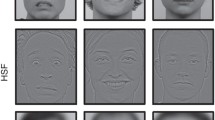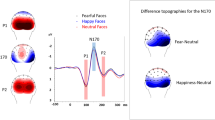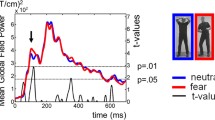Abstract
The amygdala is thought to process fear-related stimuli rapidly and nonconsciously. We found that an individual with complete bilateral amygdala lesions, who cannot recognize fear from faces, nonetheless showed normal rapid detection and nonconscious processing of those same fearful faces. We conclude that the amygdala is not essential for early stages of fear processing but, instead, modulates recognition and social judgment.

Similar content being viewed by others
References
Adolphs, R., Tranel, D., Damasio, H. & Damasio, A. Nature 372, 669–672 (1994).
Whalen, P.J. et al. J. Neurosci. 18, 411–418 (1998).
Ohman, A., Carlsson, K., Lundqvist, D. & Ingvar, M. Physiol. Behav. 92, 180–185 (2007).
Jiang, Y. & He, S. Curr. Biol. 16, 2023–2029 (2006).
Pessoa, L., Japee, S., Sturman, D. & Ungerleider, L.G. Cereb. Cortex 16, 366–375 (2006).
Mormann, F. et al. J. Neurosci. 28, 8865–8872 (2008).
Adolphs, R. Curr. Opin. Neurobiol. 18, 166–172 (2008).
Rotshtein, P., Henson, R.N., Treves, A., Driver, J. & Dolan, R.J. Nat. Neurosci. 8, 107–113 (2005).
Tsuchiya, N. & Koch, C. Nat. Neurosci. 8, 1096–1101 (2005).
Yang, E., Zald, D.H. & Blake, R. Emotion 7, 882–886 (2007).
Adolphs, R. et al. Nature 433, 68–72 (2005).
Pegna, A.J., Khateb, A., Lazeyras, F. & Seghier, M.L. Nat. Neurosci. 8, 24–25 (2005).
Lin, J.Y., Murray, S.O. & Boynton, G.M. Curr. Biol. 19, 1118–1122 (2009).
Sander, D., Grafman, J. & Zalla, T. Rev. Neurosci. 14, 303–316 (2003).
Acknowledgements
We thank C. Holcomb for help with recruiting and testing subjects. This work was funded by grants from the National Institute of Mental Health and the Simons Foundation to R.A. and was supported, in part, by Tamagawa University global Center of Excellence program of the Japanese Ministry of Education, Culture, Sports and Technology. N.T. is supported by the Japan Society for the Promotion of Science.
Author information
Authors and Affiliations
Contributions
N.T., F.M. and R.A. designed the study and wrote the paper. N.T. and F.M. executed most of the study and analyzed all of the data. C.F. and M.Y. helped with aspects of the data collection.
Corresponding author
Supplementary information
Supplementary Text and Figures
Supplementary Figures 1–4, Supplementary Table 1 and Supplementary Methods (PDF 276 kb)
Rights and permissions
About this article
Cite this article
Tsuchiya, N., Moradi, F., Felsen, C. et al. Intact rapid detection of fearful faces in the absence of the amygdala. Nat Neurosci 12, 1224–1225 (2009). https://doi.org/10.1038/nn.2380
Received:
Accepted:
Published:
Issue Date:
DOI: https://doi.org/10.1038/nn.2380
- Springer Nature America, Inc.
This article is cited by
-
Prefrontal cortex interactions with the amygdala in primates
Neuropsychopharmacology (2022)
-
Diffusion model-based understanding of subliminal affective priming in continuous flash suppression
Scientific Reports (2021)
-
Impairment of emotional expression detection after unilateral medial temporal structure resection
Scientific Reports (2021)
-
Preserved search asymmetry in the detection of fearful faces among neutral faces in individuals with Williams syndrome revealed by measurement of both manual responses and eye tracking
Journal of Neurodevelopmental Disorders (2017)
-
Dynamic Changes in Amygdala Psychophysiological Connectivity Reveal Distinct Neural Networks for Facial Expressions of Basic Emotions
Scientific Reports (2017)





